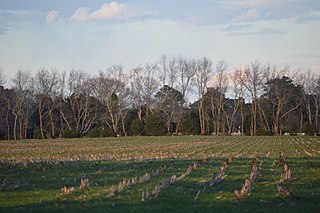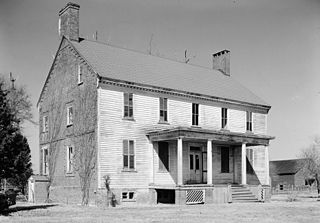
Hallwood is a town in Accomack County, Virginia, in the United States. As of the 2010 census, the town population was 206.

The Debtors' Prison is a historic debtors' prison in Accomac, Virginia. Constructed in 1783 as a house for the Accomack County jailer, it is the oldest public structure in the county. It was converted to use as a debtors' prison in 1824, which purpose it served until 1849. The prison was added to the Virginia Landmarks Register and the National Register of Historic Places in 1976; along with structures in Worsham and Tappahannock, both in Virginia as well, it is one of only three debtors' prisons in the country on the National Register.

This is a list of the National Register of Historic Places listings in Accomack County, Virginia.

Bank Building, also known as Old Mercantile Building and Eastern Shore Chamber of Commerce, is a historical commercial building located at Accomac, Virginia, Accomack County, Virginia. It was built about 1820, and it is a two-story, rectangular brick structure in the Federal style. The front facade and watertable are stuccoed. It has a gable roof and features a fanlight window above the second story door.

Bowman's Folly, is a historic home located near Accomac, Accomack County, Virginia. Captain Edmund Bowman patented the land in 1664, the current structure was built about 1815 by General John Cropper Jr., who had been born in the house in 1755. Cropper ordered it demolished and a grander building erected after construction of a hill to allow better vistas during the War of 1812. The current building has a 2+1⁄2-story, main block with a 1+1⁄2-story wing. The main block has brick ends with interior end chimneys and frame fronts on the north and south. It has a64 gable roof with dormers. The front facade features a Palladian window and pedimented entrance porch. Also on the property are a frame kitchen, now connected to the main house by a hyphen; frame dovecote, and frame privy.

Arbuckle Place is a historic home located at Assawoman, Accomack County, Virginia. It was built in 1774, and has a 1+1⁄2-story, hall and parlor plan dwelling with brick ends and frame front and back. It has a steep gable roof. The interior features complex paneling with built in cupboards and original doors and hardware. The house is a rare survivor of a once common Eastern Shore form, the small brick end house.
Bunting Place, also known as Mapp Farm and Nickawampus Farm, is a historic home and farm located at Wachapreague, Accomack County, Virginia.
Edmund Bayly House, also known as Hermitage, is a historic home located at Craddockville, Accomack County, Virginia. It was built in two stages between 1769 and 1787, and is a 1+1⁄2-story, five-bay, brick-ended frame house. It has a gable roof with dormers. The interior features fine Georgian woodwork, including an impressive parlor chimney piece with flanking cupboards, and a handsome stair. Also on the property are a contributing kitchen outbuilding, renovated for use as a guest house, and a shed.

Wharton Place is a historic home located at Mappsville, Accomack County, Virginia. It was built in 1798, and is a two-story, five-bay, brick dwelling in the Federal style. It has a one-story brick kitchen wing. It has a deck-on-hip roof and projecting interior chimneys. Also on the property is a contributing frame smokehouse. The house was built by John Wharton (1762-1811), a prosperous maritime merchant and native of Accomack County.

Pitts Neck, also known as Pitts Neck Farm, is a historic home located near New Church, Accomack County, Virginia. It consists of a two-story, five-bay, brick main block connected to a 1+1⁄2-story, two-bay frame wing connected by a hyphen. The wing dates to the beginning of the 18th century and the main block to about 25–30 years later. The main block has a central passage plan and is topped by a shallow gable roof. It features a scrolled soffit of its molded brick doorway.

Shepherd's Plain, also known as Melrose, is a historic home located near Pungoteague, Accomack County, Virginia. It was built between 1755 and 1775, and is a two-story, five bay rectangular Georgian-style dwelling with brick ends with interior end chimneys and frame fronts. It measures 39 feet by 54 feet, and has a gable roof. The interior has a central passage plan and features notable paneling in the formal parlor. It was built for Edward Ker, a prominent Accomack County planter and politician.
Willowdale, also known as Smith Place, Gunther Farm, and Willow Dale, is a historic home located at Painter, Accomack County, Virginia. It is a two-story, five-bay, gambrel roofed, frame dwelling with brick ends. There is a two-bay, single story extension that provides service from a 1+1⁄2-story kitchen with a large brick cooking fireplace at the south end. The wing dates to the early-19th century. The main block is an expansion of a 17th-century patent house of 1+1⁄2 stories that now forms the parlor at the north end of the main block. The house is representative of the vernacular "big house, little house, colonnade, kitchen" style that was common in colonial homes on the Eastern Shore of Virginia. Also on the property are the contributing ruins of a barn. Willowdale is one of the few remaining examples of the dwelling of an early colonial settler, landowner and farmer. The Smith family remained owners of Willowdale from 1666 until 2018.

Accomac Historic District is a national historic district located at Accomac, Accomack County, Virginia. The district encompasses 158 contributing buildings in the town of Accomac, mainly grouped into two periods of construction. From its founding in 1786 through the second quarter of the nineteenth century, several residential, commercial, governmental, and religious structures were built in the core of Accomac, representing both high-style and vernacular examples of late Georgian, Federal, and Greek Revival styles. Notable structures surviving from this period include the rectory of St. George's Episcopal Parish ; the Seymour House (1791-1815); Roseland (1750-1850); Seven Gables (1786-1905); Rural Hill, and the Francis Makemie Presbyterian Church (1840). The second period of construction reflected in the town dates to the last quarter of the nineteenth century, when the arrival of the New York, Philadelphia, and Norfolk Railroad spawned renewed growth and economic prosperity in Accomack County following the Civil War. These buildings also display both high-style and vernacular expressions of Victorian Era styles, including Second Empire, Italianate, Gothic Revival, and Romanesque. Notable structures from this time period include Bayly Memorial Hall, the County Clerk's Office (1887), the Accomack County Courthouse (1899), and houses found in the Lilliston Avenue extension of the town built in the 1880s-1890s. There are also contributing structures dating from the first quarter of the twentieth century, including the Drummondtown Baptist Church (1914), Drummondtown United Methodist Church (1920), and the former hotel at the town square (1925).

Central High School is a historic high school building located near Painter, Accomack County, Virginia. It was built in 1932, with an addition in 1935, and is a two-story, T-shaped, brick building with brick and stone detailing in the Art Deco style. The 1935 addition was funded by the Public Works Administration. The building served as a high school until 1984, when it was converted to a middle school. Also on the property are a contributing one-story wood-frame double classroom building, one-story vocational school building, and a one-story Colonial Revival style dwelling that served as the home economics building.

Green Garden is a historic home and farm located near Upperville, Loudoun County, Virginia. The house was built in four phases. The original section of the house was built about 1833, and is a portion of the rear ell. The main block was built about 1846, and is a two-story, five-bay, single pile brick structure in the Greek Revival style. A two-story rear ell was added about 1856, and it was connected to original 1833 section with an extension in 1921. The front facade features a three-bay porch with full Doric order entablature. Also on the property are the contributing root cellar, a smokehouse, a barn, a garage/office building, and ice house.

The Ruffner House, also known as Luray Tannery Farm, is a historic home and farm complex located at Luray, Page County, Virginia. It was built in two phases, about 1825 and about 1851. It is a two-story, Federal / Greek Revival style brick dwelling with a hipped with deck roof, a stone foundation, and one-story porches on the two fronts. The house was remodeled in the 1920s. Also on the property are the contributing rambling two-story frame residence known as The Cottage; a stone spring house with attached brick pumphouse that served an adjacent tannery; schoolhouse and shop; root cellar; secondary barn; dairy; machinery shed; chicken house; a swimming pool; an 1890s bank barn, and the small Ruffner Cemetery.

The Lawn is a historic home and national historic district located near Nokesville, Prince William County, Virginia. The main house was built in 1926 to replace the original Gothic Revival style dwelling that burned in a fire in 1921. It is a two-story, three-bay, Tudor Revival style, stuccoed dwelling. The house features half-timber framing and a complex cross gable roof. Attached to the house is a brick kitchen wing that survived from the original house. Also included in the district are a board-and-batten schoolhouse, barn, smokehouse, overseer's cottage, privy, stone dairy, and stone root cellar.

Sunnydale Farm is a historic home and farm complex located near Pound, Wise County, Virginia. The complex includes contributing and noncontributing buildings, structures, and sites dating from the 19th century or before to the 1960s. The Sunnydale Farm House, was built about 1919, and is a 1 1/2-story, frame Craftsman bungalow with vinyl and novelty weatherboard siding. Also on the property are the contributing stone well, a ruinous stone and frame root cellar, a frame chicken house, a frame blacksmith shop with a wagon and tractor, and a family cemetery. Other contributing resources are the sites of the Millard cabin and associated root cellar, coal mine openings, and the site of a coal mine tipple and bridge ruins.

Bowyer-Holladay House, also known as the Lewis Holladay House, is a historic archaeological site located near Fincastle, Botetourt County, Virginia. The site is located in The Botetourt Center at Greenfield industrial park. The site consists of the ruins of an Early Republic/Federal Style two-story brick house with a limestone lined cellar in a rear-centered ell configuration. The house was part of the plantation complex commonly referred to as the "Holladay Place." In addition to the ruins of the main house, a log structure with an early timber and modern frame addition survives 25 feet north of the bulkhead entrance to the limestone cellar.

The Pence-Carmichael Farm, Barn and Root Cellar are a pair of historic farm outbuildings in rural western White County, Arkansas. They are located just east of the hamlet of Romance, off Arkansas Highway 31 on Carmichael Lane. The barn is a two-story wood-frame structure, with a weatherboarded exterior and stone pier foundation. It has an unusual internal layout, with a transverse crib plan that has a cross-gabled drive, and a side shed extension. The root cellar is a single-story stone structure with a flat roof; it is one of the county's rare early 20th-century stone farm outbuildings.




















